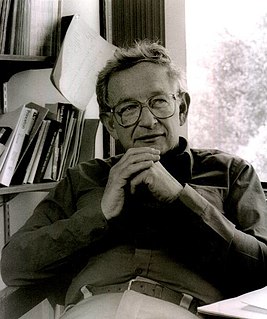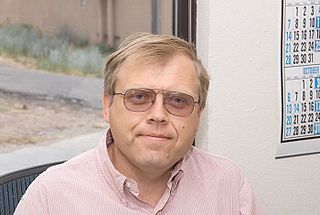
Condensed matter physics is the field of physics that deals with the macroscopic and microscopic physical properties of matter, especially the solid and liquid phases which arise from electromagnetic forces between atoms. More generally, the subject deals with "condensed" phases of matter: systems of many constituents with strong interactions between them. More exotic condensed phases include the superconducting phase exhibited by certain materials at low temperature, the ferromagnetic and antiferromagnetic phases of spins on crystal lattices of atoms, and the Bose–Einstein condensate found in ultracold atomic systems. Condensed matter physicists seek to understand the behavior of these phases by experiments to measure various material properties, and by applying the physical laws of quantum mechanics, electromagnetism, statistical mechanics, and other theories to develop mathematical models.
Metallic hydrogen is a phase of hydrogen in which it behaves like an electrical conductor. This phase was predicted in 1935 on theoretical grounds by Eugene Wigner and Hillard Bell Huntington.

Philip Warren Anderson was an American theoretical physicist and Nobel laureate. Anderson made contributions to the theories of localization, antiferromagnetism, symmetry breaking, and high-temperature superconductivity, and to the philosophy of science through his writings on emergent phenomena. Anderson is also responsible for naming the field of physics that is now known as condensed matter physics.

In condensed matter physics, a pseudogap describes a state where the Fermi surface of a material possesses a partial energy gap, for example, a band structure state where the Fermi surface is gapped only at certain points. The term pseudogap was coined by Nevill Mott in 1968 to indicate a minimum in the density of states at the Fermi level, N(EF), resulting from Coulomb repulsion between electrons in the same atom, a band gap in a disordered material or a combination of these. In the modern context pseudogap is a term from the field of high-temperature superconductivity which refers to an energy range which has very few states associated with it. This is very similar to a true 'gap', which is an energy range that contains no allowed states. Such gaps open up, for example, when electrons interact with the lattice. The pseudogap phenomenon is observed in a region of the phase diagram generic to cuprate high-temperature superconductors, existing in underdoped specimens at temperatures above the superconducting transition temperature.
In solid-state physics, an energy gap is an energy range in a solid where no electron states exist, i.e. an energy range where the density of states vanishes.

David R. Nelson is an American physicist, and Arthur K. Solomon Professor of Biophysics, at Harvard University.
Juan Carlos Campuzano is a Paraguayan American physicist. He is a Distinguished Professor of Physics at the University of Illinois at Chicago. He was a Distinguished Fellow at Argonne National Laboratory, and a he is also a 2001 American Physical Society Fellow and a recipient of the 2011 Oliver Buckley Prize in Condensed Matter Physics. He is an expert in high-temperature superconductivity.

Piers Coleman is a British-born theoretical physicist, working in the field of theoretical condensed matter physics. Coleman is Professor of Physics at Rutgers University in New Jersey and at Royal Holloway, University of London.
In condensed matter physics, the resonating valence bond theory (RVB) is a theoretical model that attempts to describe high temperature superconductivity, and in particular the superconductivity in cuprate compounds. It was first proposed by an American physicist P. W. Anderson and Indian theoretical physicist Ganapathy Baskaran in 1987. The theory states that in copper oxide lattices, electrons from neighboring copper atoms interact to form a valence bond, which locks them in place. However, with doping, these electrons can act as mobile Cooper pairs and are able to superconduct. Anderson observed in his 1987 paper that the origins of superconductivity in doped cuprates was in the Mott insulator nature of crystalline copper oxide. RVB builds on the Hubbard and t-J models used in the study of strongly correlated materials.
Thomas Felix Rosenbaum is an American physicist and the current President of the California Institute of Technology. Earlier he served as Provost and on the faculty of the University of Chicago, and was the Vice President for Research at Argonne National Laboratory.

Alexander V. Balatsky is a USSR-born American physicist. He is the professor of theoretical physics at NORDITA and University of Connecticut. He served as the founding director of the Institute for Materials Science (IMS) at Los Alamos National Laboratory in 2014-2017.

Alexandre Bouzdine (Buzdin) is a French and Russian theoretical physicist in the field of superconductivity and condensed matter physics. He was awarded the Holweck Medal in physics in 2013 and obtained the Gay-Lussac Humboldt Prize in 2019 for his theoretical contributions in the field of coexistence between superconductivity and magnetism.

Andrew Peter Mackenzie is a director of Physics of Quantum Materials at the Max Planck Institute for Chemical Physics of Solids in Dresden, Germany and Professor of Condensed Matter Physics at the University of St Andrews, Scotland. He became a co-editor of the Annual Review of Condensed Matter Physics as of 2020.
Jules P. Carbotte was a Canadian physicist, professor at McMaster University and a Fellow of the Royal Society of Canada. His research interests spanned many areas of theoretical condensed matter physics.
Mohit Randeria is a US-based Indian condensed matter physicist and a professor of physics at Ohio State University. Known for his research on condensed matter theory and superconductivity, Randeria is an elected fellow of the American Physics Society. The Council of Scientific and Industrial Research, the apex agency of the Government of India for scientific research, awarded him the Shanti Swarup Bhatnagar Prize for Science and Technology, one of the highest Indian science awards, for his contributions to physical sciences in 2002. He was awarded the 2002 ICTP Prize of the International Center for Theoretical Physics, Trieste and the 2022 John Bardeen Prize.

Thomas Maurice Rice is an Irish theoretical physicist specializing in condensed matter physics.
Egor Babaev is a Russian-born Swedish physicist. In 2001, he received his PhD in theoretical physics from Uppsala University (Sweden). In 2006 he joined the faculty of the KTH Royal Institute of Technology in Stockholm. In 2007-2013 he shared this position with a faculty appointment at Physics Department of the University of Massachusetts, Amherst (USA). He is currently full professor at the Physics Department KTH Royal Institute of Technology.
Yvan J. Bruynseraede is a condensed matter experimental physicist, known for his work on multilayers and superlattices, and his interests are thin films, nanostructures, novel materials, magnetism, and superconductivity. He is currently Professor Emeritus at the Catholic University of Leuven (KULeuven), and a member of the Quantum Solid-State Physics Laboratory.
Allen Marshall Goldman is an American experimental condensed matter physicist, known for his research on electronic transport properties of superconductors and for the eponymous Carlson-Goldman mode involving collective oscillations in superconductors.
Kazumi Maki was a Japanese theoretical physicist, known for his research in "superconductivity, superfluid ³He, and quasi‑one‑dimensional (1D) materials."








